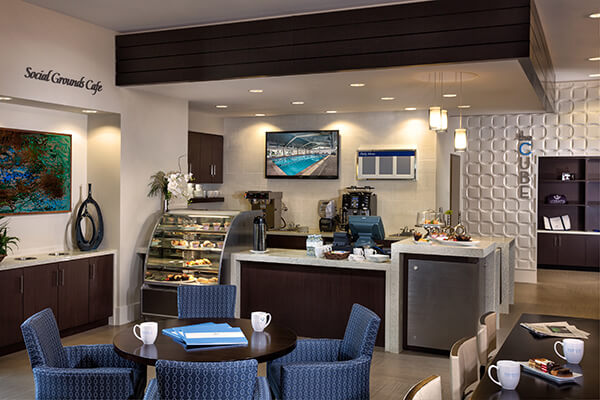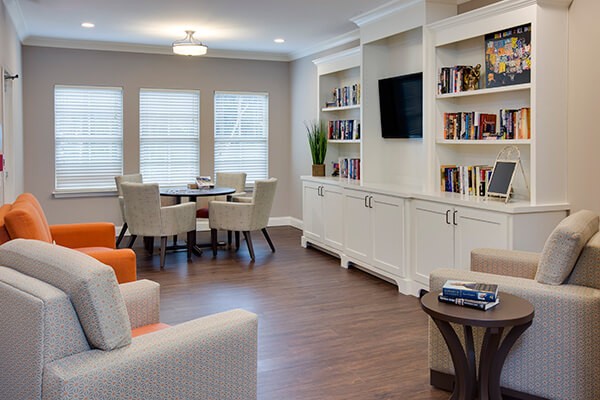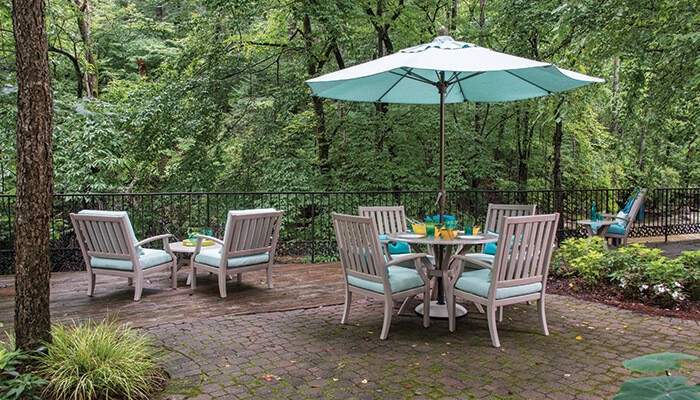Senior living interior design is evolving. The median age of senior housing residents is now 87 and is increasing by .8 every year. As a result, assisted living and independent living residents are increasingly frail and have more acute conditions.
While interior designs should be stylish and attractive to impress potential new residents, it is also necessary to blend both form & function. Below are just a few ways you can design for older seniors while still creating beautiful interiors:
1. Design with Home Comforts in Mind
Residents want to live in an environment that makes them comfortable and feel they are living in dignity. Consider both functional layouts and products, while choosing stylish and transitional styles, finishes and fabrics. Example: Move away from rockers or recliners lining the hallway to a common area that looks more like someone’s living room or a hotel lounge.
 2. Increase Interactions with Smaller Scale
2. Increase Interactions with Smaller Scale
As seniors are less mobile and more confined to their resident rooms, it is important to create smaller community areas that allow for more intimate interactions. For example, instead of large dining rooms design more options like a Bistro, grab & go salad bar, coffee shop or a restaurant atmosphere. This provides an increased level of intimacy, while also creating unique design environments that have their own personalities.
3. Personalize Designs to the Local Community
Senior Living interior designs used to follow cookie cutter large scale models. Now people are designing based on the larger community to create more local personalization. This is both reflected in the style of the interiors, as well as partnering with local businesses to bring their services inside (i.e. a restaurant or a local yoga studio).
4. Accommodate for More Wheelchairs and Walkers
Prevent clutter and walking hazards by opening up hallways, but also look at creative ways to accommodate storage. For example, develop a parking area for walkers outside a dining area. While these functional areas are designed for residents and staff to make parking and retrieving the mobility aids easier, you can use lattices or stone work to screen the space and add visual appeal .
5. Use Furniture Ergonomically Designed for Seniors
Furniture can be both stylish and serve the needs of older residents. Make sure to select furniture with some of the following features:
- Weight is balanced correctly to prevent tipping, but is also not too heavy to move
- Designed to help residents get in and out of chairs independently.
- Materials and construction that make it easier for staff to clean spills and crumbs
- Uses hand grips to help re-position a resident when at the table
- Built with durable materials to prevent dings and scuffs from wheelchairs and walkers. This will both maintain the integrity of the furniture and also give a great first impression when family members of potential residents are touring.
6. Adjust the Lighting
As aging seniors’ eyes can become sensitive, you’ll want to find ways of using light to create attractive settings without creating glare. “Hot spots” of light and sharp adjustments can create more risk of falling since aging eyes don’t adjust as rapidly.. You can ensure there is enough light that is part of a beautiful interior design by using multiple modes of delivery (i.e. chandeliers, lamps, etc.)
7. Create Meaningful Outdoor Spaces
Senior living interior design also extends outside. Use outdoor settings to increase residents’ quality of life.
- Create healing gardens – Provide immersive nature areas that include various plants to stimulate multiple senses, various walk surfaces for physical therapy, and walking trails that welcome independent activity and improve resident health
- Design various outdoor sitting areas to stimulate socialization and community
- Develop outdoor group event areas to increase activity participation
- Make use of specialized planting tables and potting benches to provide residents with minimal mobility an additional outdoor activity
8. Make Smart Flooring Choices
Flooring can have a big impact. You must consider both how it looks, but also adjust to the challenges of older seniors.
- More spills means the need for a microbial barrier and easy to clean materials
- The increasing age of seniors necessitates more mobility aids. If you’re going to use carpet or tiles, make sure they have design patterns in the middle of walkways to mask the wear caused by wheelchairs and walkers.
- Ensure a strong contrast between walls and flooring to increase visual discrimination between vertical and horizontal surfaces.
- Use colors that are harmonious and easy on the eyes of seniors to prevent falls, but are also attractive to guests. This can be with carpet tiles or faux stone and faux wood vinyl since they both look attractive and are safer.
9. Create Efficient Resident Rooms
In skilled nursing many rooms are still double occupancy so you can use free-standing caseoods (drawers mirrored on each side, desk, etc.) to divide the room instead of an ugly hospital curtain. This also allows light to flow through the room making residents more comfortable. There is currently a movement toward modular casegoods that combine a number of casegoods pieces e.g. dressers, wardrobes, benches, desks and bookshelves in order to conserve space and improve the flow of movement in smaller rooms.
Kwalu Can Help
As you are looking at interior design plans for new locations or a remodel, consider requesting finish and fabric samples from Kwalu to be part of your design boards. Furniture can be custom built for any setting or you can check out our Senior Living furniture.
